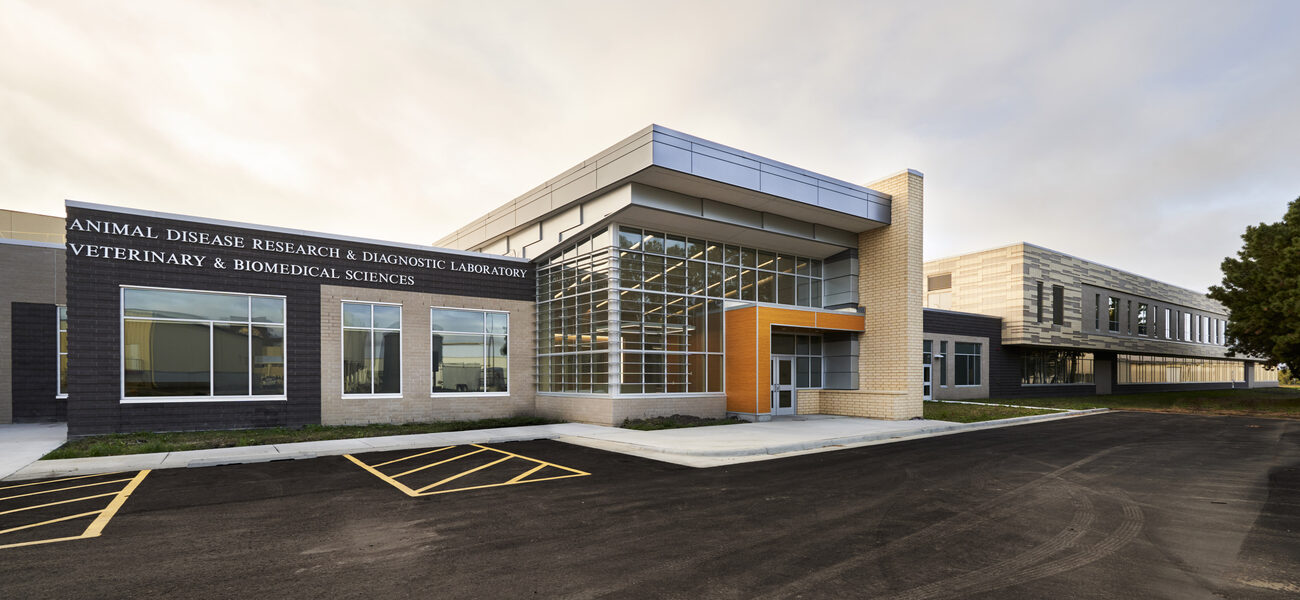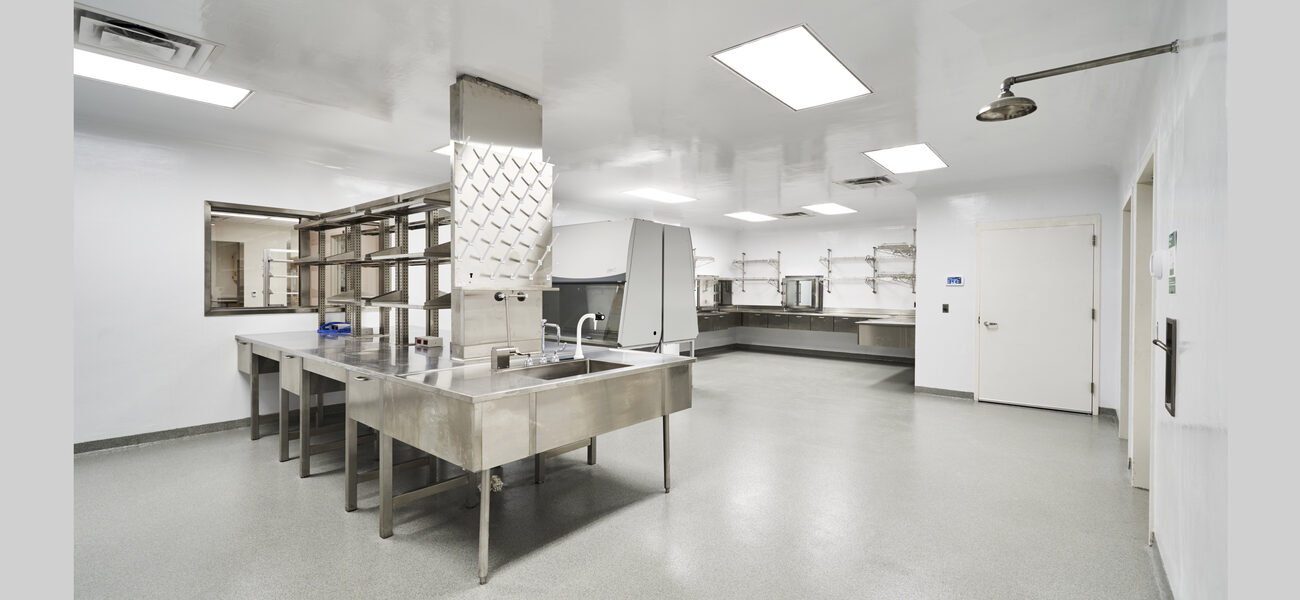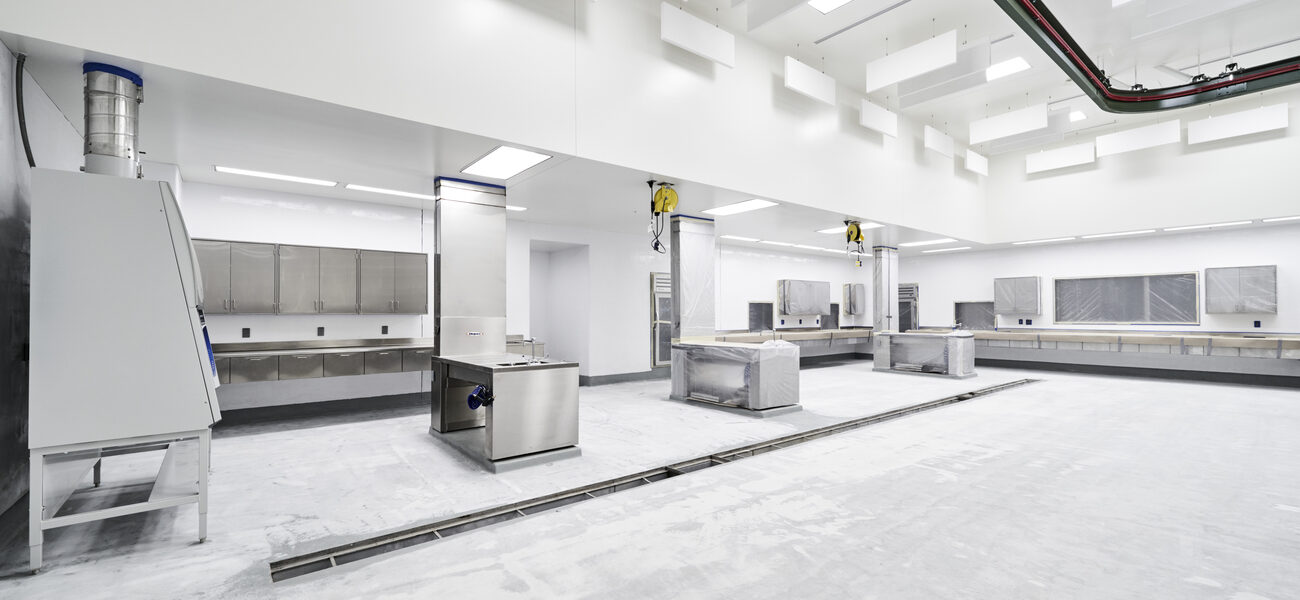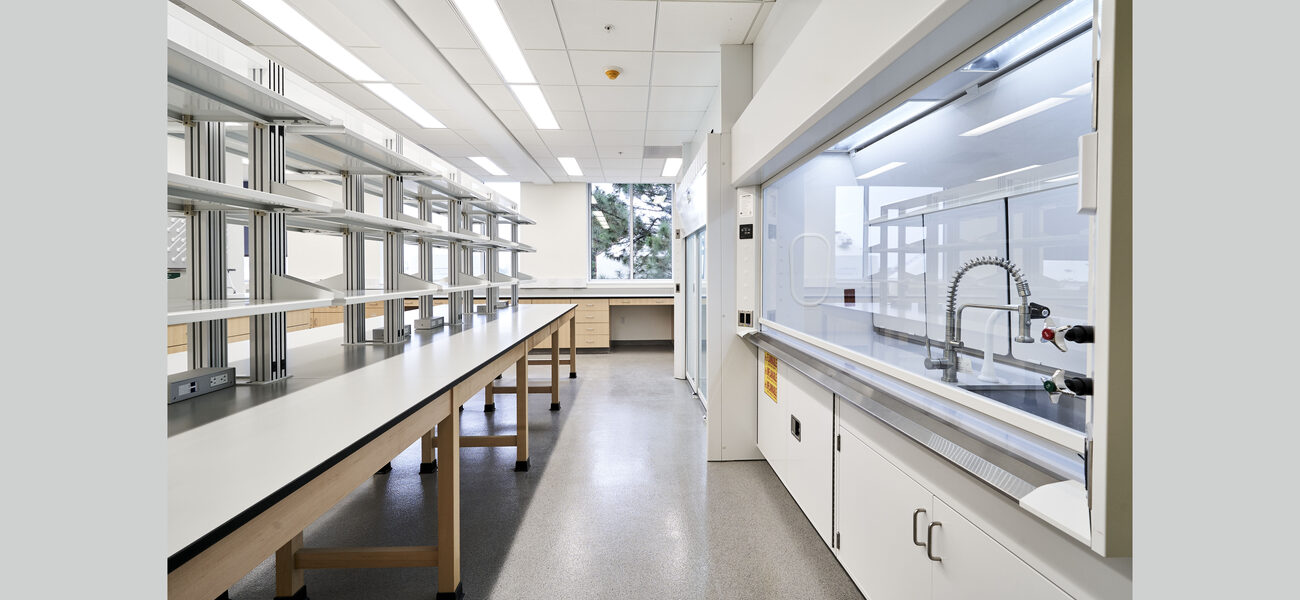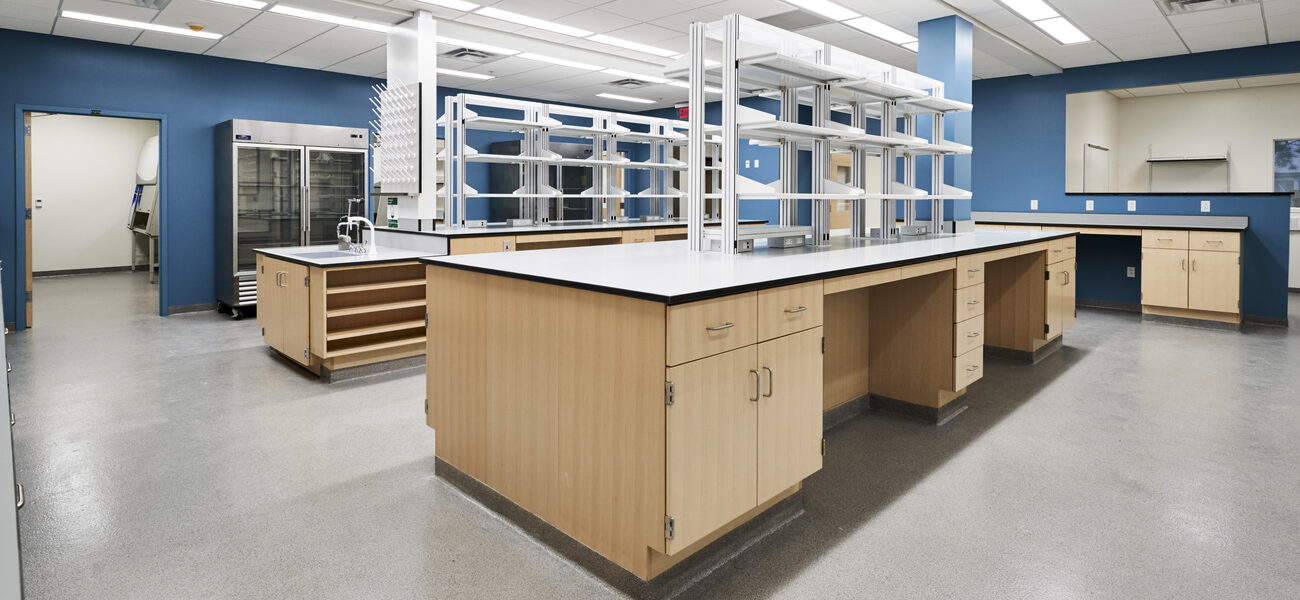An “onion skin” layout of lab adjacencies and biocontainment strategies derived from a thorough risk assessment process are highlights of the new construction for the South Dakota Animal Disease Research and Diagnostic Laboratory (ADRDL) in Brookings, S.D. The new 84,000-gsf (41,000-nsf) building, an addition to the original facility, will provide space to accommodate the burgeoning demand for molecular diagnostics while bringing activities on both sides of the ADRDL mission—research and diagnostics—under one roof.
The design allows clients to drop off samples at a drive-in window for biocontainment and biosecurity purposes. Samples taken on the conventional necropsy floor can be handed off directly to the appropriate technical section without having to pass through corridors. And the adjacent BSL-2+ necropsy floor can be closed off for testing suspect animals and organisms without interrupting the regular workflow.
The new construction will be followed by renovation of the current building, with the entire project winding up in summer 2020.
“The project drivers were growth and maintenance issues in our current facility. Our need was based on emerging diseases in animal and public health,” says Jane Christopher-Hennings, DVM, director of the ADRDL.
Testing Protects Large Livestock Industry
Agriculture is the number one industry in South Dakota, where the state’s growing livestock population (12.3 million in 2014) generates a total economic impact upward of $6.3 billion yearly. While most states operate their own veterinary diagnostic labs, the ADRDL receives samples from about 35 different states due to its high-throughput livestock testing. The ADRDL operates within South Dakota State University’s Veterinary and Biomedical Sciences Department, which Christopher-Hennings also heads.
Molecular diagnostics accounts for some 40 percent of the lab’s annual volume of half a million tests. More than two-thirds of those tests involve swine samples. Cattle, companion animals, wildlife, and food safety testing make up the rest.
“Our clients are very proactive in testing,” observes Christopher-Hennings.
These large numbers reflect the ADRDL’s front-line position preventing and containing animal disease. Another critical role is to advance a long tradition of discovery and innovation—from identifying a virus that caused a mystery swine disease called PRRS (porcine reproductive and respiratory syndrome) 30 years ago to supporting NIH-funded research into influenza D today.
Onion Skin Furthers Containment
A linear extension angling off the existing building, the new ADRDL comprises two stories of lab space topped by two mechanical levels. This approach allows all equipment servicing and maintenance to be performed without having to enter the controlled access areas below.
The building’s technical sections, key areas for the detection and diagnostics of pathogens, are: bacteriology, parasitology, virology, serology, DNA sequencing, molecular diagnostics, clinical pathology, histopathology, and the state food safety lab. Histopathology/tissue prep, bacteriology, virology, and the sample receiving sections are located on the first floor, clustered around and plugged into the necropsy floors at the center.
An arriving carcass is taken to the conventional necropsy floor for conventional operations. If it is suspect, it can be moved directly to the BSL-2+ (enhanced) necropsy area for a higher level of containment. With the doors closed, other operations can still proceed in the adjacent conventional necropsy area. Tissue samples from a suspect case can be passed into the BSL-3 lab for testing. This lab also includes shower and autoclave areas.
The pass-through connections between the necropsy floor and the technical sections are important for a number of reasons, explains Andrew Stepp, senior principal at The Clark Enersen Partners. During benchmarking tours Stepp noticed a trend moving away from the onion skin concept. Instead, new designs have the animal dock and necropsy floor as standalone pieces, a layout that requires samples to be moved along building hallways to the appropriate diagnostic section.
“It is complicated to make the plan fit together properly, so the onion skin concept is often jettisoned,” says Stepp. “But this group saw the benefits for containment in retaining it.”
The scheme also has a lot of merit for the facility users. “The diagnostic groups, staff, and lab techs like it for communication,” he continues. “Pathologists working on the necropsy floor don’t have to get on the phone to find out what’s going on. People can just open the pass-through window and talk. They really use that core necropsy room and windows to stay in contact.”
Risk Assessment
To make sure the ADRDL addressed the pillar principles of biosafety containment and risk assessment in a cost-effective way, the planning team involved the building’s commissioning agent early in the project.
Noting that the latest edition of BMBL (Biosafety in Microbiological and Biological Laboratories) allows some flexibility in addressing the two principles, Dan Frasier, principal and director of commissioning at Cornerstone Commissioning, emphasizes the importance of approaching risk assessment as a process whose steps include gathering input from occupants on their programs and procedures.
“The bottom-line issue is preventing laboratory-associated infections,” says Frasier. “As commissioning agents, we’re always asking, how can we simplify this facility? How can we make the supporting systems and controls work more easily? When involved during the design phase, we can help owners get the building they need to have without spending money on things they’ll never use.”
Frasier points out that the thinking on containment has evolved, and some measures that were trendy 10 years ago aren’t necessarily helpful today, often becoming problematic from an operational or maintenance perspective.
One example is the use of maglocks (magnetic locks) in interlocking door schemes. It’s fairly easy for building users to overlook the latching step, which then prevents others from accessing the area. The maglocks can also develop maintenance issues.
Frasier proposes a very low-tech solution: a standard operating procedure (SOP) that directs users to simply look through the door window to make sure someone else is not opening the door on the other side. “I know you have to get people to comply with this, but it is such a better way to operate, and it eliminates the need for override buttons, which often malfunction anyway.”
Another area that has been subjected to overdesign stems from the latest BMBL mandate to avoid airflow reversals.
“People started doing all kinds of creative things, like putting a UPS (uninterruptible power supply) on exhaust fans and opting for more active pressure controls,” says Frasier. “I can tell you from experience that these things create instability. They rip walls off.”
He does, however, strongly endorse the installation of redundant exhaust fans in BSL-3 facilities. “We recommend that you at least have N+1 fans running all the time. If you lose one, you’re not ramping up a fan to get back to the static pressure set-point.”
Airflow direction control is also critical.
“The time that you really need containment is when a door is open,” says Frasier. “We marry the tightness of the doors, the amount of volumetric offset between supply and exhaust, so that when we test airflow direction, there is usually more than 100 CFM offset at a door.”
Waste Treatment
The risk assessment process for liquid and solid waste treatment revealed additional opportunities for simplification through SOPs. An effluent decontamination system (EDS) for killing all kinds of potential biohazards is a typical feature of veterinary diagnostic laboratories, but not always necessary. Frasier cites one lab project with an EDS that has never processed waste at the BSL-3 level in its 10 years of operation. Installed at the cost of $500,000, plus requisite infrastructure, it was a difficult capital expense to justify.
The ADRDL planning team carefully analyzed the probabilities and consequences of various methods of waste disposal given the large-animal species, the infectious agents, the environment, and all related procedural issues. The goal became treating potential contaminants at the point of use, within the necropsy floors or the BSL-3 lab, instead of via a more expensive EDS.
“It is much simpler and cheaper, and probably even more bullet proof, to control effluent at the necropsy floor, capturing it in trenches that drain from the side—drains on the bottom catch debris and plug more readily—and then biologically inactivate it with bleach or another chemical,” says Frasier. The team also checked with local officials to make sure there were no additional pre-treatment requirements for liquid waste disposal from the building piping into the municipal sewer system.
If a whole carcass suspected of hoof and mouth disease is in the BSL-2 necropsy floor, the trench drains are set up to shut off to contain the animal effluent so it doesn’t go into the municipal system before being effectively chemically treated.
Two sterilizers in the BSL-2 enhanced necropsy floor allow material to be sterilized directly, before final disposal in the incinerator or the rendering truck.
In the BSL-3 lab, which works only with samples, not carcasses, all effluent is contained under sinks in carboys, which are then collected and treated. This process allows them to drain into the dedicated drainage, waste, and vent system serving the BSL-3 and enhanced necropsy areas
Room Integrity
According to Stepp, major risks in the BSL-3 spaces are posed not only by infectious agents but also by the subsequent gaseous decontamination process. Gas concentrations are so high that they are potentially lethal, so the absolute integrity of all room penetrations is imperative.
These requirements must be clearly communicated to contractors, starting early in the planning process. To build understanding and establish relationships, the construction manager was engaged even before the architects. Weekly meetings with the contractors have been very helpful during the construction process, says Christopher-Hennings. “We just go out to the trailer, and they give us updates.”
A well-thought-out set of documents is critical, adds Frasier. “We try to leave no stone unturned on the biocontainment architectural detail sheets. We show details for an electrical conduit penetrating several different wall, ceiling, and floor types, and the same for ducts and plumbing. You have to cover all the bases, so the contractors understand what they are getting into.”
Invaluable Benefits
In the end, the benefits of a well-executed risk assessment process are invaluable, says Frasier.
“You end up getting the right kind of systems, installed and maintained correctly, accessible without disruption to lab activity. Systems that support the program should not be so cumbersome that they bog down the institution and require resources that take funding away from the programs,” he concludes.
By Nicole Zaro Stahl
| Organization | Project Role |
|---|---|
|
Clark & Enersen
|
Architect
|
